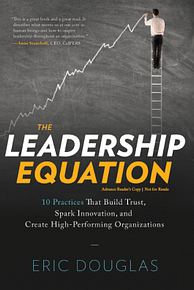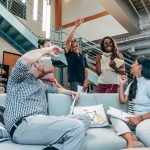
How do you build a productive, positive culture? What are the important things that a leader can do to influence an organization’s culture? What levers can you use?
Let’s start by looking at some of the ways cultures are described. Here are some largely positive descriptors:
And here are some not-so-positive descriptors:
So what are the levers one can use to shift or change a culture? The chart below lays out the important things that leaders can do to create a positive culture.
As you look at these things, ask yourself: Which do we have in place, which don’t we have? What’s my role in addressing the gaps? This will help you figure out ways to develop your culture.
As a leader, another way to help change a culture is to change the stories that people tell. Do people dwell on what’s not going well? You can change that. You can find ways to reshape the narrative, whether it’s about their particular team about the whole organization.
 For example, we worked with the CEO of a non-profit who inherited an organization that had been run very autocratically by her predecessor. She immediately started communicating in a new way, saying: “Jim was a great leader for his time. But I believe our best years are ahead.” She then went on to say: “Here are three ways we are going to be different. First, we’re going to embrace diversity in all its forms. Second, we’re going to listen to everyone’s ideas and elevate the best ones. Third, we’re going to set clear priorities.”
For example, we worked with the CEO of a non-profit who inherited an organization that had been run very autocratically by her predecessor. She immediately started communicating in a new way, saying: “Jim was a great leader for his time. But I believe our best years are ahead.” She then went on to say: “Here are three ways we are going to be different. First, we’re going to embrace diversity in all its forms. Second, we’re going to listen to everyone’s ideas and elevate the best ones. Third, we’re going to set clear priorities.”
“Embrace diversity. Elevate good ideas. Prioritize.” She repeated those themes over and over in her employee meetings. She shared examples, for instance, how the IT director solicited ideas and then put together a plan showing what system upgrades people could expect by when. “Embrace diversity. Elevate good ideas. Prioritize” became a mantra across the organization. And today, the culture is described as innovative and visionary.
A culture is reflective of its people, processes, and systems. We know it through the processes that are used to manage and operate the business. Some of these are informal rituals, like a morning huddle or monthly lunch with the boss. We know it through recurring events like all-staff picnics.
 I’ve worked for an array of different organizations and consulted with the leaders of hundreds of organizations. Drawing on that experience, I wrote a book, The Leadership Equation, that describes how to build a “leadership culture.” What I look for in a leadership culture is captured in the graphic below.
I’ve worked for an array of different organizations and consulted with the leaders of hundreds of organizations. Drawing on that experience, I wrote a book, The Leadership Equation, that describes how to build a “leadership culture.” What I look for in a leadership culture is captured in the graphic below.
These two dimensions together create a culture where people “run it like they own it.” This is the leadership culture. My book details ten major ways that leaders can build this kind of culture.

Note: Click here to check out a sample chapter of my latest book, The Leadership Equation.
Do people feel fulfilled and excited by the work they do? Do they like their bosses? Do they feel committed to the organization’s mission and values? Do they feel supported? Do they feel trusted? Do they look forward to coming to work? Those are all hallmarks of a positive workplace culture. This kind of culture doesn’t just happen on the natural. It occurs because people take ownership and identify the kind of culture they want. So think about it – what kind of culture do you want to see? And what can you do to start building it today?
Related Post: Building Focus and Trust in Virtual Teams
 Our team of experts has extensive experience in helping organizations transform their workplace culture for the better. We’ll work with you to identify the values and behaviors you want to promote and provide guidance on how to incorporate them into every aspect of your business.
Our team of experts has extensive experience in helping organizations transform their workplace culture for the better. We’ll work with you to identify the values and behaviors you want to promote and provide guidance on how to incorporate them into every aspect of your business.
Our customized solutions are designed to meet the unique needs of your organization and provide you with the tools and support you need to build a positive work environment. We’ll work with you every step of the way to ensure that your workplace culture aligns with your business objectives and reflects your company’s values.
Investing in building a positive workplace culture is an investment in the future of your business, and we’re here to help you achieve that success. So don’t wait any longer, take action today, and partner with our consulting firm to transform your work environment and create a better working world for everyone. Contact us to learn how we can meet your needs.
Leading Resources, Inc. is a Sacramento Leadership Development firm that develops leaders and leading organizations. Subscribe to our leadership development newsletter to download the PDF – “The 6 Trust-Building Habits of Leaders” to learn more about how to build trust with your team.